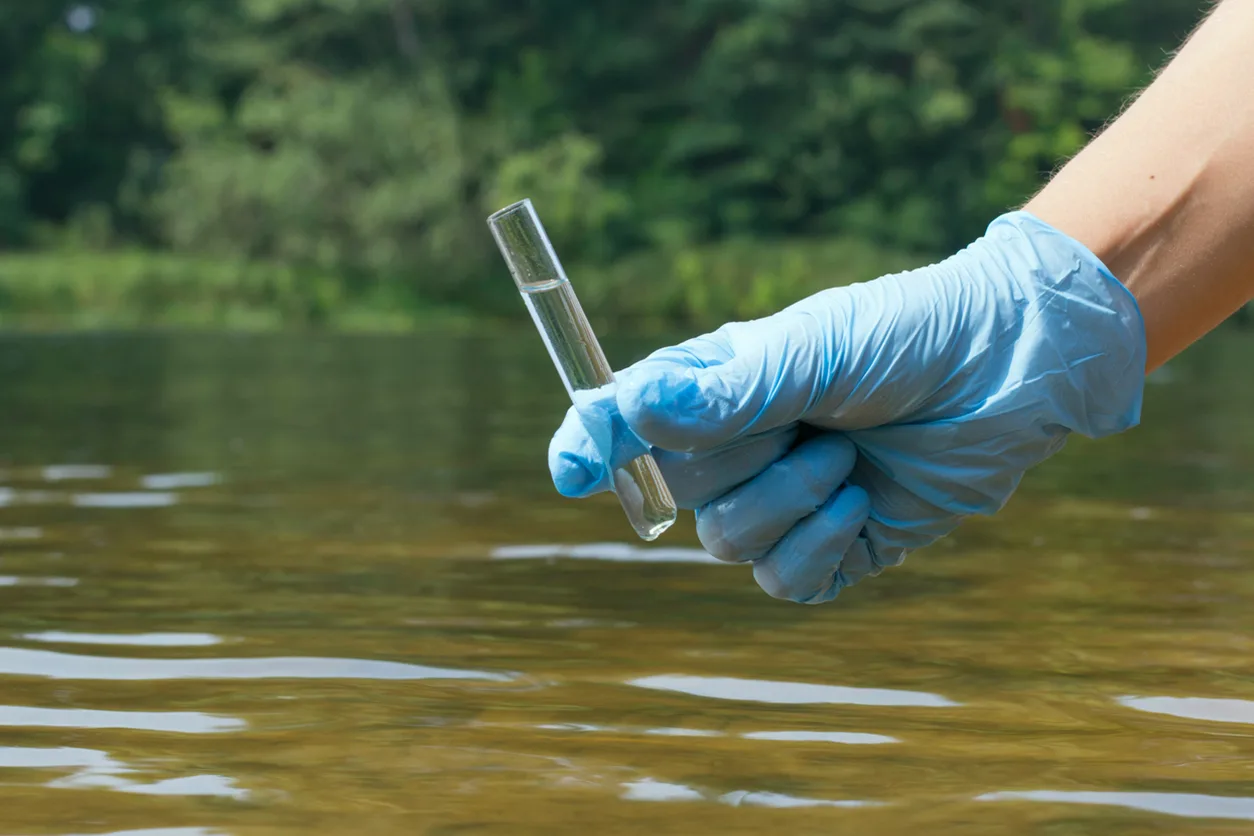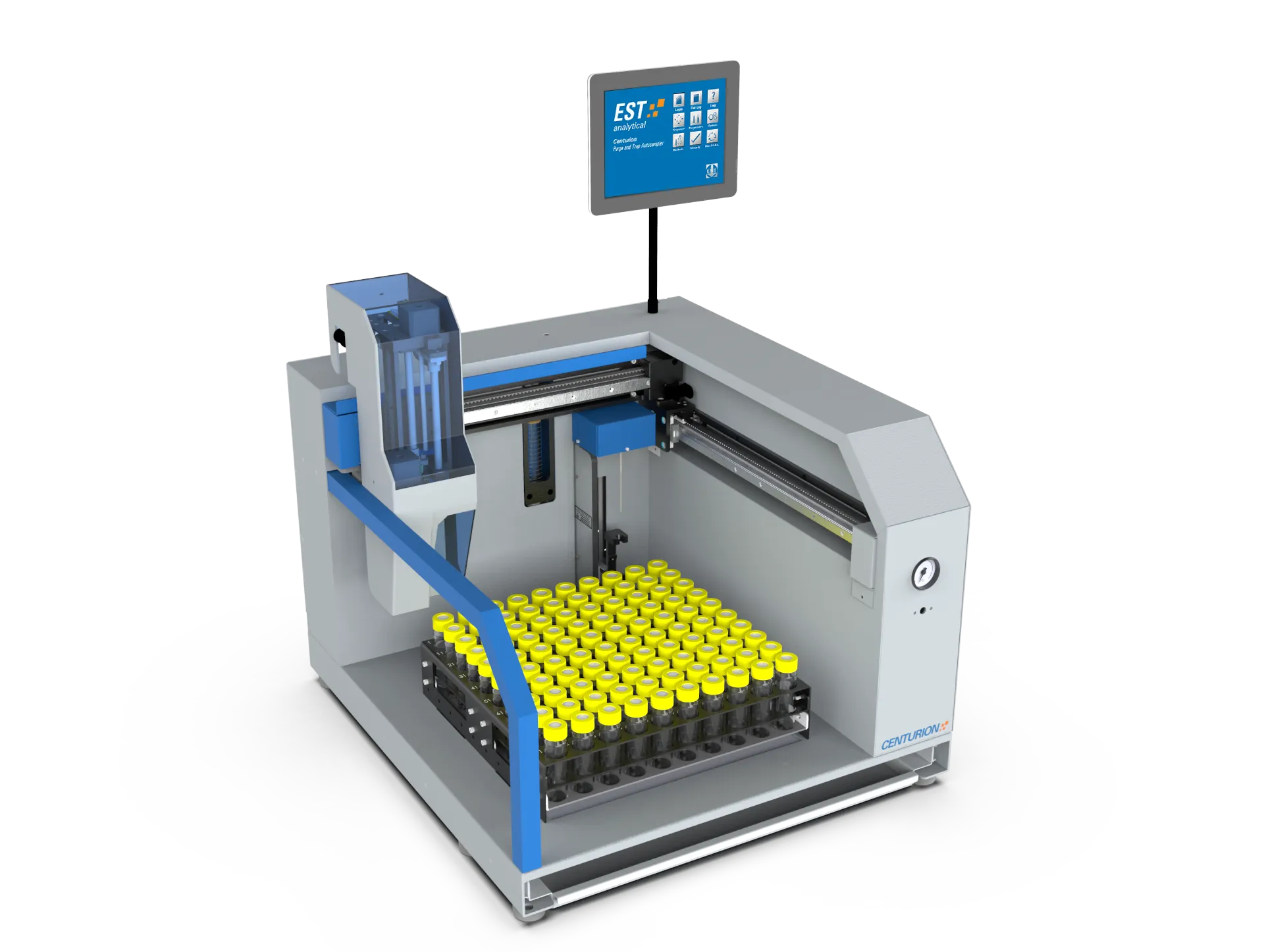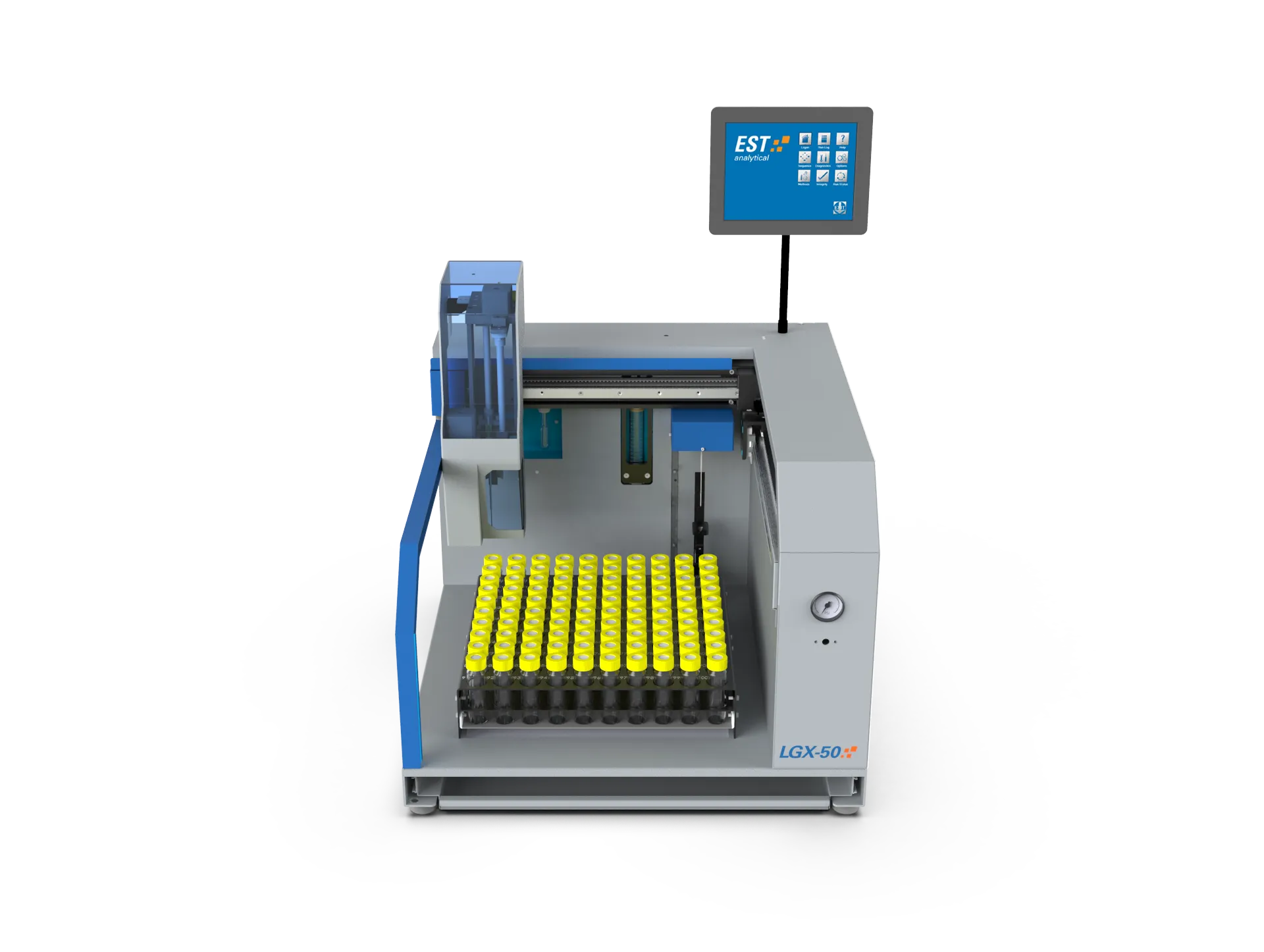Purge and Trap EPA 8260 and EPA 624

Method 8260 incorporates several preparative techniques including purge and trap (USEPA Method 5030 and 5035) and headspace sampling (USEPA Method 5021). For wastewater compliance monitoring the USEPA promulgated Method 624. This method is used for the determination of VOCs in municipal and industrial waste water using purge and trap sampling. Since Method 8260 and 624 both involve water matrices, many laboratories run an extended compound list in order to accept both types of water samples.
USEPA Method 8260 encompasses over 100 compounds, many of which can be determined using a purge and trap preparative technique. Method 5030 describes the purge and trap procedure for the determination of VOCs in water or water miscible samples. While Method 5035 applies to solid, oil, sludge or tar… matrices. Both methods involve purge and trap sampling in conjunction with Gas Chromatography/Mass Spectrometry (GC/MS) for the determination of the VOCs.
Whitepapers
Helium is the second most abundant element in the universe but makes up only 0.0005% of the earth’s atmosphere. Helium has many uses including cooling superconducting magnets for Nuclear Magnetic Resonance (NMR) or Magnetic Resonance Imaging (MRI), and since it is inert, it can also be used as a carrier gas for Gas Chromatography/Mass Spectrometry (GC/MS). During purge and trap concentration, Helium is used to purge volatile analytes out of the sample matrix in order to concentrate them onto an analytical trap. Due to the Helium shortage, it has become necessary to find another means of purging analytes out of the sample. This application will examine using Nitrogen as the purge gas for purge and trap sampling.
Method HJ639-2012 was implemented March 1st, 2013. The method recommends an analytical trap composed of 1/3 Tenax 1/3 silica gel 1/3 active carbon or a “C” trap. As the method requires a two minute desorb time, the silica gel in the C trap can be problematic. This application will compare the C trap with the Vocarb 3000 trap for their efficacy when following the HJ-639 method.
Environmental laboratories are always searching for techniques to increase productivity. However, environmental methods demand a large amount of background information in order to ensure sampling and analysis is compliant. The determination of Volatile Organic Compounds (VOCs) in the United States Environmental Protection Agency (USEPA) Method 8260 encompasses many different matrices and in doing so has numerous sampling, quality control, and calibration requirements. The matrices of Method 8260 samples can also vary from air to sludge and from clean to extremely contaminated. Furthermore, the method has an extensive calibration range. All of these factors play into the complexity of sampling and analysis thus, creating ways to streamline sampling while still maintaining sample integrity and method compliance is always of interest to environmental laboratories.
During volatile analysis, samples are purged with an inert gas in order for the Volatile Organic Compounds (VOCs) to be swept out of the sample matrix and onto an analytical trap. For years, the established and recommended purge flow rate and time has been 40ml/min for 11 minutes. However advances in instrumentation technology have led to the potential for greater efficiencies in conducting VOC analysis. This study reviews four sets of time and flow parameters and their respective outcomes.
The United States Environmental Protection Agency (USEPA) Method 624 is employed to determine purgeable industrial pollutants in environmental samples. The latest revision is based on the previous method. However, due to the many updates to sampling and analysis instrumentation, many of the method requirements can be more stringent than is required in the method.
The United States Environmental Protection Agency (USEPA) Method 8260 is used in order to ascertain volatile organic compounds in waters, soils and solid waste samples. Often times, soil and solid waste samples are so highly contaminated the sample needs to be dispersed in methanol. Sample collection for contaminated soils can be obtained in two ways. One, dispersing a bulk soil sample into a 40ml vial and adding methanol in the lab or two, sending pre-weighed vials with a septum sealed cap that already contains the pre-requisite methanol out in the field for soil sampling. No matter how the soil sample is dispersed in methanol, an aliquot of the methanol extract needs to be added to water and purged using USEPA Method 5030. This application will investigate automated sampling of methanol soil extractions.
The United State Environmental Protection Agency (USEPA) Method 8260 recommends an eleven-minute purge time at 40ml/min purge flow. Due to this restriction, environmental analysts need to investigate other means to decrease cycle times without sacrificing analytical results. This application note will examine decreasing cycle times within the USEPA Method requirements.
Due to current events, the importance of determining volatile petroleum hydrocarbons in both soils and waters has become an issue. The complexities of the matrices that these compounds are found in can also inhibit accurate detection. Analysis of volatile petroleum hydrocarbons by purge and trap concentration in conjunction with GC/MS will be presented in this poster.
Liquefied Petroleum Gas (LPG) is a group of hydrocarbon gases typically compromising three or four carbon atoms. The most common forms of LPG are propane (C3H8), propylene (C3H6), butane (C4H12) and butylenes (C4H8). Being colourless and odourless necessitates the addition of odourants to LPG to aid detecting unsafe situations. These odourants are normally the sulfur containing compounds mercaptanes, which are added at an approximate concentration of less than 10 ppmS. Measurement of the Total Sulfur (TS) content in natural gas streams is important both in avoiding sulfur related pipeline corrosion and for the determination of precise quantity of odorant that must be added to the LPG. LPG and other light hydrocarbons are also finding use as feedstocks for a variety of new refining technologies. The need for low sulfur measurements in this part of the industry is of a growing importance. Furthermore, LPG is increasingly used as an automotive fuel and must therefore comply with legislations concerning the sulfur content of automotive fuels, the limits of which are decreasing in last decade.
1,2,3-Trichloropropane (1,2,3-TCP) is usually found at industrial waste sites. It can be used as a solvent or as a degreasing agent and is also a chemical intermediate when synthesizing other compounds. 1,2,3-TCP does not typically leach into soil, thus it is commonly found in ground water. Since it is a highly carcinogenic chemical and has been found to be a common contaminant in ground water, California has established 1,2,3-TCP as a hazardous compound with a notification level of 0.005-micrograms per liter (μg/L) in drinking water. While in Europe, 1,2,3- TCP is listed as a substance of very high concern that may cause cancer and is toxic for reproduction. This application will examine purge and trap sampling in conjunction with Gas Chromatography/Mass Spectrometry (GC/MS) for the determination of low levels of 1,2,3-Trichloropropane.
1 4 Dioxane is commonly used as a cleansing agent during the manufacture of pharmaceuticals. It is also employed as a stabilizer for chlorinated solvents, so it is commonly found at industrial sites contaminated with these solvents. The Environmental Protection Agency (EPA) has classified 1 4 dioxane as a likely carcinogen and thus it is essential to be able to detect 1 4 dioxane at low concentration levels.
Polycyclic Aromatic Hydrocarbons (PAHs) are formed from incomplete burning of carbon containing fuel. There are thousands of PAH compounds in the environment, and of those; there are several that have been established to begin with of concern for the environment. Extraction of PAH compounds involves a large amount of sample and solvent, and because of this, there is a lot of solvent waste. The use of Large Volume Injection (LVI) in conjunction with a Programmable Temperature Vaporizer (PTV) aids in eliminating some of this solvent waste, and reduces labor and shipping costs due to the ability to extract smaller volumes of sample without sacrificing sensitivity. This analysis will compare PAH compound response of a standard injection versus a large volume injection.
The United States Environmental Protection Agency (USEPA) Method 8260 has an extensive list of analytes that can be analyzed by purge and trap sampling. Two of the more troublesome compounds on this list are Ethanol and 1 4 Dioxane. Both of these compounds are water miscible and Selective Ion Monitoring (SIM) is required in order to detect these compounds at lower levels. This application will compare linearity, method detection limits, precision and accuracy and carryover of several purge and trap sampling parameters.
Environmental testing laboratories are always trying to find ways to increase sample throughput using purge and trap. One of the larger problems laboratories incur is highly contaminated, “hot”, samples. If a sample is hot, there is the possibility of contaminating the purge and trap concentrator. Cleaning up this contamination is as problematic as it is time consuming and therefore negatively impacts sample throughput. There are several ways to get around this challenge each with its own benefits and drawbacks. One potential solution is using Solid Phase Micro Extraction (SPME). This application will examine the efficacy of ASTM Method D-6889, “Fast Screening for Volatile Organic Compounds in Water Using Solid Phase Microextraction (SPME)”, for environmental sample screening.
Volatile contaminants in drinking, ground and wastewaters are an ongoing environmental concern throughout the world. Testing for these contaminants is generally done using a Gas Chromatograph (GC) coupled to a Mass Spectrometer. However, sampling for these compounds is dependent on the environmental regulations of the country in which you are testing. The USEPA methods for extracting VOCs from environmental samples require purge and trap sampling. On the other hand, in Europe and Canada, it is common to use static headspace sampling for the measurement of VOCs.
Carryover is a common problem resulting in sample reruns and reduced productivity in environmental labs. Many advances over the years have been developed to tackle this issue. These innovations vary from increasing bake times and bake flows to changing the flow path tubing to more inert materials. This application will evaluate a patented innovation for cleaning the sparge vessel during an analytical sequence.
The Environmental Protection Agency (EPA) has classified 1,4-Dioxane as a likely carcinogen that does not break down readily. Purge and trap concentration and liquid-liquid extraction are the most common techniques for the sampling of 1,4-Dioxane. Each of these techniques has its advantages and drawbacks. This application will explore Solid Phase Microextraction as a possible option for the sampling of 1,4-Dioxane.
Over the past decade, the need for environmental laboratories using purge and trap systems to report at or below the Method Detection Limit (MDL) has created many new challenges. As a result of the required lower detection levels, water management, analyte migration and carryover reduction have become a critical concern to meet linear calibration criteria. This paper will present the optimum purge and trap system parameters used to generate USEPA Method 8260B data. The conditions utilized will provide the necessary sensitivity, linearity and accuracy compliant to the method. In particular, the revolutionary advancements used to virtually eliminate carryover and manage the moisture will be highlighted. Analytical results including calibrations factors, method detection limits and reproducibility data will be presented.





